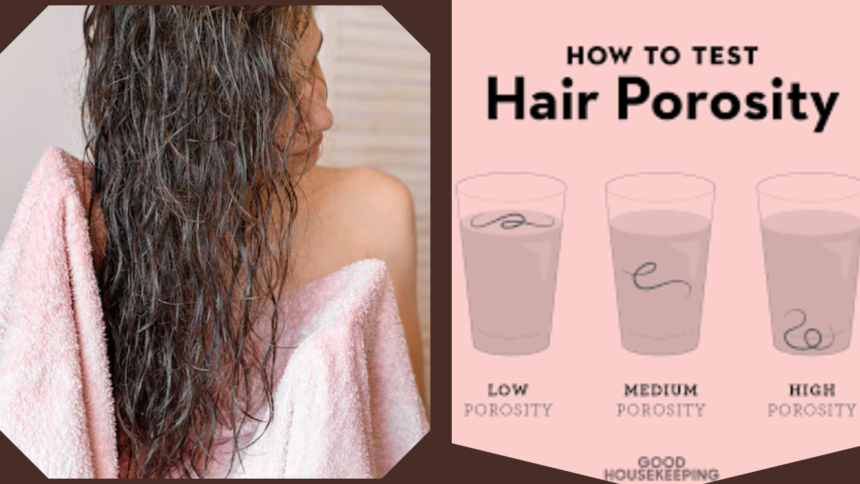High porosity hair is a common hair type characterized by its ability to absorb and release moisture quickly. While this can make the hair more responsive to treatments and styling products, it can also lead to challenges such as dryness, frizz, and breakage. Understanding how to care for high porosity hair is crucial for maintaining its health and appearance. Here’s a comprehensive guide to help you manage and care for high porosity hair effectivel
Table of Contents
What is High Porosity Hair?
Hair porosity refers to the hair’s ability to absorb and retain moisture. High porosity hair has a more open cuticle layer, allowing moisture and products to penetrate quickly but also leading to faster moisture loss. This can result from various factors, including genetics, chemical treatments, and environmental damage.
Characteristics of High Porosity Hair
- Quick Moisture Absorption: High porosity hair absorbs moisture rapidly but also loses it just as quickly.
- Dryness and Frizz: Because it loses moisture fast, high porosity hair can often feel dry and appear frizzy.
- Tangled and Knotted: The open cuticle layer can make the hair more prone to tangling and knotting.
- Easily Damaged: High porosity hair is more susceptible to damage from heat styling, chemicals, and environmental stressors.
Causes of High Porosity Hair
High porosity hair can result from several factors:
- Genetics: Some individuals naturally have high porosity hair due to their genetic makeup.
- Chemical Treatments: Frequent use of hair dyes, relaxers, or perms can damage the cuticle, increasing porosity.
- Heat Damage: Excessive use of heat styling tools like flat irons and curling wands can compromise the hair’s structure.
- Environmental Factors: Exposure to sun, wind, and harsh weather conditions can contribute to increased porosity.
Caring for High Porosity Hair
1. Moisturize Regularly
- Use Leave-In Conditioners: Leave-in conditioners can help maintain moisture levels throughout the day.
- Deep Conditioning Treatments: Apply deep conditioning masks or treatments once a week to replenish moisture and strengthen hair.
2. Seal in Moisture
- Oils and Butters: Use natural oils (like argan oil, coconut oil, or olive oil) or butters (such as shea butter) to seal in moisture and reduce dryness.
- Layering Techniques: Apply a moisturizer and then seal with an oil or butter to lock in hydration.
3. Gentle Cleansing
- Use Sulfate-Free Shampoos: Choose shampoos that are free from sulfates to prevent further stripping of moisture.
- Avoid Over-Washing: Wash your hair no more than 2-3 times a week to prevent excessive moisture loss.
4. Protect from Damage
- Heat Protection: Use heat protectant sprays or serums before styling with heat tools to minimize damage.
- Avoid Over-Manipulation: Minimize styling and handling to reduce breakage and frizz.
5. Choose the Right Products
- Protein Treatments: Incorporate protein treatments into your routine to strengthen the hair and reduce breakage.
- Hydrating Products: Opt for products specifically designed for high porosity hair, which often have higher moisturizing properties.
Styling Tips for High Porosity Hair
- Avoid Heavy Products: Heavy styling products can weigh down the hair and make it look greasy. Instead, use lightweight products that provide hydration without buildup.
- Opt for Protective Styles: Protective hairstyles like braids, twists, and buns can help reduce exposure to environmental stressors and minimize damage.
Additional Tips for High Porosity Hair
- Regular Trims: Trim your hair every 6-8 weeks to remove split ends and prevent further damage.
- Cold Water Rinse: Rinse your hair with cold water after conditioning to help close the cuticle and retain moisture.
- Use a Silk or Satin Pillowcase: These materials are gentler on the hair compared to cotton, reducing friction and preventing breakage.
Conclusion
High porosity hair requires specific care to keep it healthy and manageable. By focusing on regular moisturizing, sealing in moisture, gentle cleansing, and protecting from damage, you can maintain the health and appearance of high porosity hair. With the right products and techniques, you can address the unique challenges of high porosity hair and enjoy its natural beauty.
Frequently Asked Questions About High Porosity Hair
Q1: How can I tell if my hair is high porosity?
A: Perform a simple porosity test by placing a strand of hair in a glass of water. If the hair sinks quickly, it’s likely high porosity. Additionally, high porosity hair often feels dry and absorbs products rapidly.
Q2: Can I change my hair’s porosity?
A: While you can’t change your hair’s natural porosity, you can manage and improve its condition through appropriate care and treatments. Using the right products and techniques can help maintain moisture and reduce the impact of high porosity.
Q3: Are there any specific products I should avoid for high porosity hair?
A: Avoid products with high alcohol content, as they can further dry out the hair. Also, steer clear of heavy, build-up-prone products that can weigh down the hair and make it greasy.
Q4: How often should I use protein treatments on high porosity hair?
A: Protein treatments should be used in moderation, generally every 4-6 weeks, depending on your hair’s needs. Overuse can lead to brittleness, so it’s essential to balance protein with moisture.
Q5: Can high porosity hair grow long and healthy?
A: Yes, high porosity hair can grow long and healthy with proper care. Focus on moisturizing, protecting, and minimizing damage to ensure your hair remains strong and resilient.
Stay in touch for more updates and alerts visit: eightsleep!









